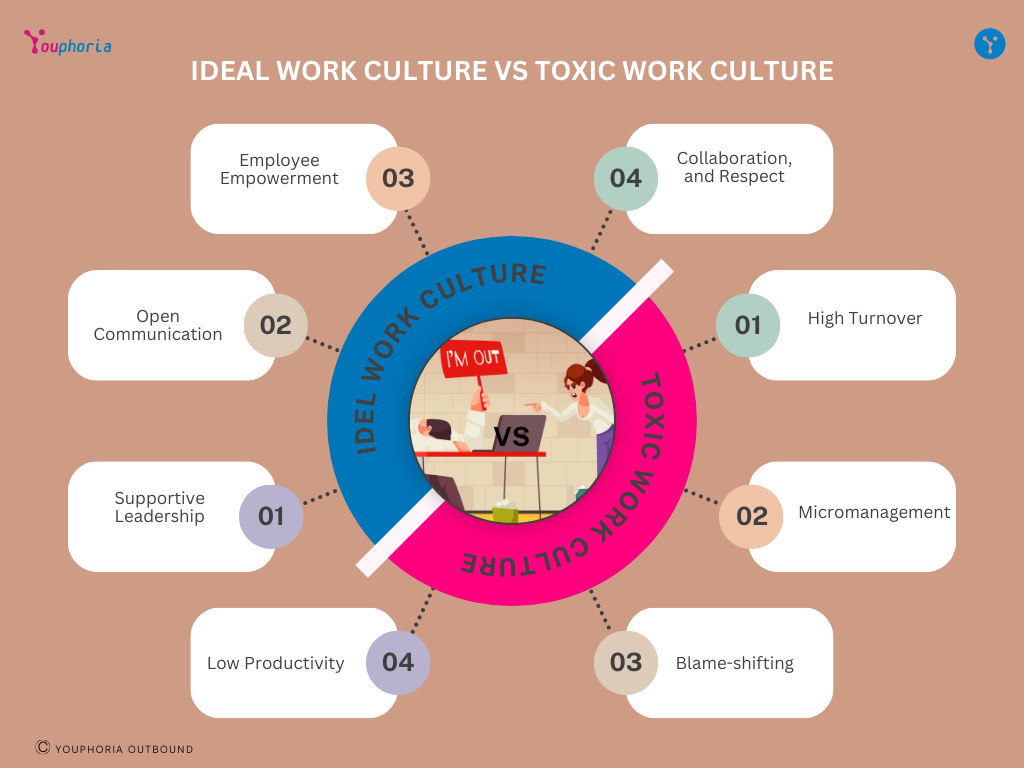A business’s work culture is its foundation—it impacts every corner of operations, from employee engagement to development to delivery to customer satisfaction and summarizes companies’ image. When a workplace culture becomes toxic, it spreads across teams like blood in veins, affecting productivity, morale, and turnover rates. The challenge? Focusing on correcting individual employees instead of addressing the larger, systemic cultural issues often misses the mark and leaves these problems unresolved.
Here, we’ll dig in what defines an ideal work culture versus a toxic one, the detrimental impacts of a toxic work culture, and why it’s essential to correct the culture first.

Small contribution of inputs which defines the Toxic vs. Ideal Work Cultures
1. Defining Toxic Work Culture
A toxic work culture is one in which employees feel undervalued, unsafe, and pressured. Here are some general factor:
- Low morale: Employees feel discouraged, drained, and unmotivated due to lack of recognition, support, or purpose.
- Micromanagement: Leaders frequently control minor details of employees’ tasks, stifling autonomy and innovation.
- High turnover: Employees leave regularly because they don’t feel satisfied or valued, which increases hiring costs and strains teams.
- Bullying and blame culture: Conflicts aren’t managed constructively, and blame-shifting replaces problem-solving.
- Burnout: High-stress demands and lack of work-life balance lead to exhaustion, decreased productivity, and health issues.
A toxic work culture harms both employees and the organization by promoting discontent, reducing performance, and damaging the company’s reputation and more importantly flow.
2. Characteristics of an Ideal Work Culture
An ideal culture, on the other hand, cultivates a sense of respect, trust, and alignment between individual and organizational goals. Characteristics include:
- Employee empowerment: Employees have the freedom to make decisions and are trusted in their roles.
- Clear communication: Leaders communicate transparently, and employees feel comfortable sharing feedback.
- Recognition and appreciation: Efforts are acknowledged regularly, leading to a positive work atmosphere.
- Healthy work-life balance: The organization respects personal time, helping employees maintain energy and focus.
- Team collaboration: Employees work together toward shared goals in a supportive environment that values diverse perspectives.
How Toxic Work Culture Impacts Business Success
A toxic work culture affects every layer of an organization, from performance to profit margins. Here’s how:
1. High Employee Turnover and Low Retention
Studies show that 57% of employees leave jobs due to “bad work culture” rather than the actual work itself. Organizations with a toxic culture spend significantly more on recruiting and training new employees, costing valuable resources.
2. Poor Employee Well-Being and Burnout
According to the WHO, burnout costs the global economy nearly $1 trillion annually due to lower productivity. Toxic cultures contribute heavily to burnout, creating a work environment that harms employees’ mental and physical health.
3. Decline in Innovation and Creativity
When micromanagement, fear, and blame dominate the workplace, employees are less likely to share ideas and contribute creatively. They are likely to less interested in staying invested. Studies indicate that 35% of employees feel that a lack of autonomy and respect in the workplace stifles their innovation potential.
4. Low Morale and Job Satisfaction
A Gallup survey found that only 21% of employees worldwide feel engaged at work. In a toxic culture, morale is low because employees don’t feel valued or empowered. This dissatisfaction directly affects productivity, customer service, and profitability.
5. Reduced Customer Satisfaction and Brand Reputation
A positive employee experience leads to a positive customer experience. Conversely, a toxic work culture often results in poor customer service, affecting brand reputation and customer loyalty.
Why Correcting Culture is More Effective than Correcting Employees
- Systemic Change Has a Broader Impact: Correcting work culture creates a ripple effect that impacts all employees, whereas focusing on individual corrections only addresses symptoms.
- Improved Accountability and Trust: When leaders model supportive behavior and fair practices, it builds a culture of accountability. Employees follow suit, creating a stronger, trust-based work environment.
- Sustainable Solutions for Long-Term Success: Changing the culture is a long-term solution that promotes a positive work environment for current and future employees, whereas employee correction is often a short-term fix.
- Boosts Employee Retention and Satisfaction: Employees are more likely to stay with organizations that foster an ideal work culture, which leads to higher retention, lower turnover, and enhanced company loyalty.
- Increases Productivity and Performance: A healthy culture promotes engagement and motivation, directly influencing individual and team productivity.
Global Statistics: The Cost of Ignoring Work Culture
- A report from the Society for Human Resource Management indicates that globally, toxic work environments impact billions of dollars across sectors due to absenteeism, turnover, and lost productivity. Many countries, especially in fast-growing economies, are seeing rising costs as companies struggle to adapt to supportive workplace practices.
- Gallup reports that companies with an ideal work culture see a 21% higher profitability and a 41% reduction in absenteeism.
- The Society for Human Resource Management (SHRM) states that 1 in 5 employees leaves a job because of workplace culture, and those can’t afford to leave or stuck are more likely to contributing to increased costs associated with sick leave, mental health support, and reduced performance.
Although exact figures are less frequently reported, studies indicate that the mental and physical toll of toxic workplaces across globally is profound. Many employees endure high stress due to intense expectations and limited legal protections, resulting in significant burnout, reduced productivity, and higher turnover rates
Steps to Transform a Toxic Work Culture
- Assess and Acknowledge: Use surveys and feedback to understand the culture and recognize existing toxic patterns. Acknowledge these issues openly.
- Implement Training and Development: Offer workshops that emphasize empathy, emotional intelligence, and teamwork. Leaders need to understand the importance of fostering a positive work environment.
- Encourage Open Communication: Build a culture where employees feel safe to voice concerns. Implement regular check-ins and anonymous feedback channels to keep lines of communication open.
- Model Positive Behaviors: Leaders should model positive, inclusive, and empowering behaviors to set a standard for the rest of the organization.
- Promote Work-Life Balance: Establish policies that encourage healthy work hours, flexible schedules, and support for mental and physical health.
- Celebrate Wins and Recognize Efforts: Acknowledge employee achievements, big or small, to show appreciation and boost morale.
- Build Accountability Structures: Hold everyone accountable for their actions and contributions, from executives to entry-level employees.
- Develop Anti-Bullying and Anti-Micromanagement Policies: Create guidelines and protocols that explicitly address bullying and excessive control in the workplace.
- Invest in Team Building: Regular team-building activities strengthen relationships, promote collaboration, and enhance trust within teams.
- Monitor and Adjust: Culture is dynamic. Continuously monitor it through feedback loops and be willing to adjust policies and strategies as needed.
Conclusion
Correcting workplace culture, rather than individual behaviors alone, is the key to creating a sustainable and productive environment. By fostering an ideal culture, organizations can enhance employee satisfaction, productivity, and retention rates while reducing costs and strengthening brand reputation.
A thriving work culture is essential for any organization to succeed in today’s world, and a supportive culture doesn’t just make a good workplace—it makes a great one.
This emphasizes that creating a healthy work environment isn’t just beneficial for employees; it’s critical for organizational success. By addressing work culture, organizations create an empowered, engaged, and motivated workforce that drives long-term growth and satisfaction.







No comment yet, add your voice below!